PL-100 : Microsoft Power Platform App Maker : Part 04
-
You are an app designer for a hotel.
The hotel wants to create an app to help the housekeeping staff schedule work.
You need to create a new environment for the app.
Where should you create the environment?
- Power Platform Admin center
- Power Apps Maker portal
- Dynamics 365 Admin center
Explanation:
Manage environment in the Power Platform admin center. -
A company delivers products to multiple communities. The company creates a canvas app connected to a Common Data Service database. The app tracks communities to see where the delivery volume is the highest.
Drivers must enter delivery information on a form that uses an entity named Delivery. Depot staff must enter information on a pick-up form that uses an entity named Pick-up. Each form contains a community field that is based on a shared list across both forms.
You need to create the community field.
Which type of field should you create?
- local option set
- text
- global option set
- text area
Explanation:Can use a global option set, no need to use localized option sets.
Note: In PowerApps Option set is one of the field types you can use in your Entity. The information type that Option Set stores is a list of text values. And here comes the Option Set advantage – once you define its text values you can centrally managed it.
-
A company has an on-premises system that stores product information. The company plans to replace the information with a Power Platform solution that uses the Common Data Service.
The Power Platform solution needs to use data from the product information system.
You need to transform and import the data from the product information system.
Which two tools should you use? Each correct answer presents part of the solution.
NOTE: Each correct selection is worth one point.
- Dataflow
- Business process flow
- Power BI Desktop
- Data gateway
Explanation:The on-premises data gateway acts as a bridge to provide quick and secure data transfer between on-premises data (data that isn’t in the cloud) and several Microsoft cloud services. These cloud services include Power BI, PowerApps, Power Automate, Azure Analysis Services, and Azure Logic Apps. By using a gateway, organizations can keep databases and other data sources on their on-premises networks, yet securely use that on-premises data in cloud services.
Can use the Power Platform dataflows to load entity in CDS with the option to transform data.
-
DRAG DROP
You are creating entities in a Common Data Service database to capture sales data.
You create an entity named Sales that includes the following fields:

PL-100 Microsoft Power Platform App Maker Part 04 Q04 014 You create a new entity that includes a field named TotalSales. The field is used to capture the aggregated sales for each salesperson.
You need to configure the fields for the entities.
Which field types should you use? To answer, drag the appropriate field types to the correct field names. Each field type may be used once, more than once, or not at all. You may need to drag the split bar between panes or scroll to view content.
NOTE: Each correct selection is worth one point.

PL-100 Microsoft Power Platform App Maker Part 04 Q04 015 Question 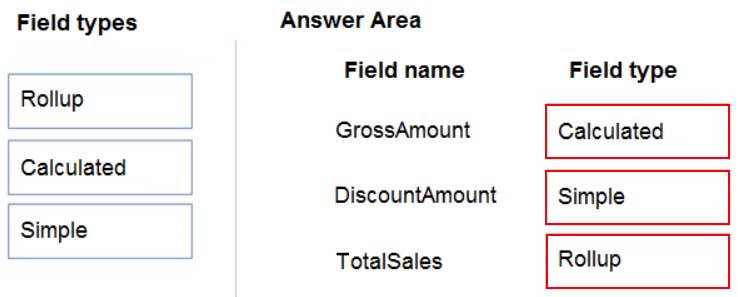
PL-100 Microsoft Power Platform App Maker Part 04 Q04 015 Answer Explanation:Box 1: Calculated
Calculated columns are calculated in real-time when they are retrieved. Calculated columns can be composed using different data types. For example, an Integer calculated column may reference values from Decimal or Currency columns.Box 2: Simple
A simple column isn’t defined as a calculated or rollup column.Box 3: Rollup
Because rollup columns persist in the database, they can be used for filtering or sorting just like regular columns. -
In a Common Data Service database, you create a canvas app and a custom entity. The app also reads data from the Account entity in the Common Data Service database.
Entity access permissions will be controlled by the Common Data Service User security role. You create a Common Data Service solution.
You need to replicate the changes to a new Common Data Service database.
Which two components should you include with the canvas app? Each correct answer presents part of the solution.
NOTE: Each correct selection is worth one point.
- Custom entity
- Account entity
- Common Data Service User security role
- Sitemap
-
HOTSPOT
You need to create a model-driven app without using code.
Which tools should you use? To answer, select the appropriate options in the answer area.
NOTE: Each correct selection is worth one point.
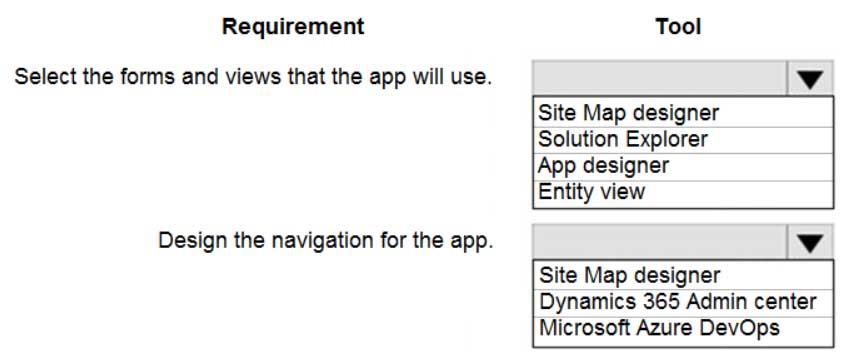
PL-100 Microsoft Power Platform App Maker Part 04 Q06 016 Question 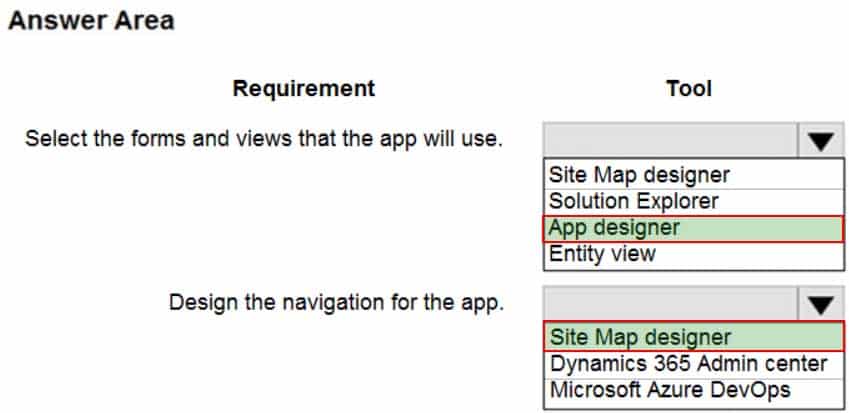
PL-100 Microsoft Power Platform App Maker Part 04 Q06 016 Answer Explanation:Box 1: App designer
As an app maker, you can create and edit public views by using Power Apps.Box 2: Site Map designer
Site maps define the navigation for your app. Create a site map for your app with ease by using the tile-based site map designer. -
HOTSPOT
You are creating a capacity planning dashboard with Power BI desktop.
The dashboard must be able to be used within a model-driven manufacturing planning app as well as be embedded within a Microsoft Teams channel.
The data sources are as follows:

PL-100 Microsoft Power Platform App Maker Part 04 Q07 017 You need to determine the appropriate method for accomplishing each task.
Which methods should you use? To answer, select the appropriate options in the answer area.
NOTE: Each correct selection is worth one point.
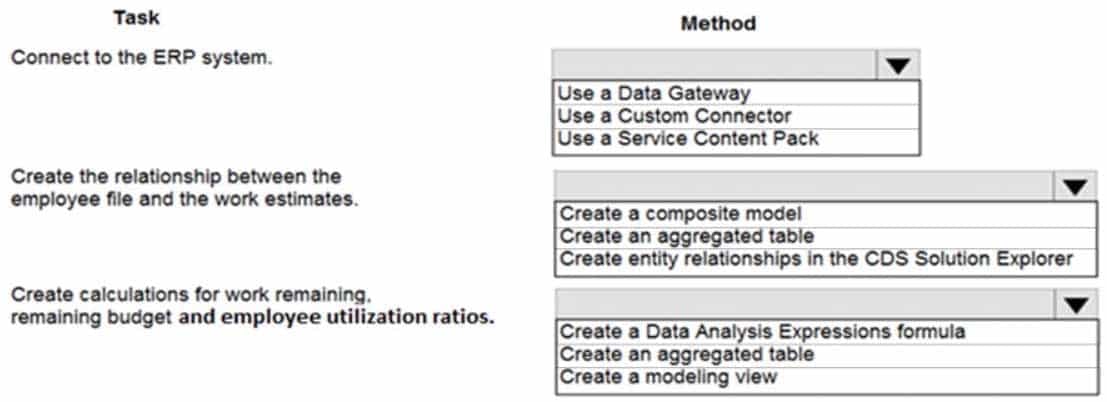
PL-100 Microsoft Power Platform App Maker Part 04 Q07 018 Question 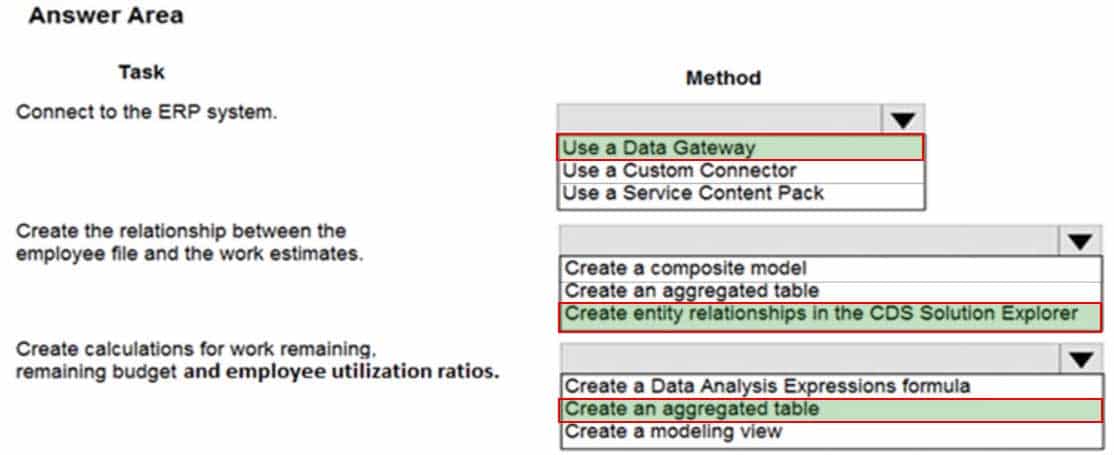
PL-100 Microsoft Power Platform App Maker Part 04 Q07 018 Answer Explanation:Box 1: Use a Date Gateway
You can install an on-premises data gateway on the same local computer as SQL Server (in production, it would typically be a different computer).Box 2: Create an entity relationship in CDS Solution Explorer
You can create relationships with CDS Solution Explorer.Box 3: Create an aggregate table
Rollup columns help users obtain insights into data by monitoring key business metrics. A rollup column contains an aggregate value computed over the rows related to a specified row. This includes regular tables and activity tables such as emails and appointments.Incorrect Answers:
– Data Analysis Expressions (DAX) is a library of functions and operators that can be combined to build formulas and expressions in Power BI, Analysis Services, and Power Pivot in Excel data models.
– With Modeling view in Power BI Desktop, you can view and work with complex datasets that contain many tables. -
Note: This question is part of a series of questions that present the same scenario. Each question in the series contains a unique solution that might meet the stated goals. Some question sets might have more than one correct solution, while others might not have a correct solution.
After you answer a question in this section, you will NOT be able to return to it. As a result, these questions will not appear in the review screen.
You build a canvas app for a manufacturing company. The company receives parts and materials from many vendors. You create a form to collect information from packing slips.
Receivers must be able to take a picture of packing slips to receive materials instead of manually entering data in the app.
You need to ensure that users can scan packing slip information into the form.
Proposed solution: Use a Text Recognition model.
Does the solution meet the goal?
- Yes
- No
Explanation:
Create a canvas app and add the text recognizer AI Builder component to your screen. This component takes a photo or loads an image from the local device, and then processes it to detect and extract text based on the text recognition prebuilt model. If it detects text in the image, the component outputs the text and identifies the instances by showing a rectangle for each instance in the image. -
HOTSPOT
Rangers in national parks report wildlife they encounter during patrols. The rangers record observations in a notebook when they are on patrol. The rangers manually enter observation data when they are in the office. You are designing an app that allows rangers to record their observations while they are on patrol.
The wildlife is modeled as a custom table named Wildlife. The model has relationships to the annotation entity and to a custom entity named Wildlife Details. In the Wildlife Details entity, rangers capture more information as they observe an animal’s habitat. When observing wildlife, rangers must indicate whether an animal requires medical attention. The app must synchronize and save data to Common Data Service when connectivity is available.
You need to design the app.
What should you do? To answer, select the appropriate options in the answer area.
NOTE: Each correct selection is worth one point.
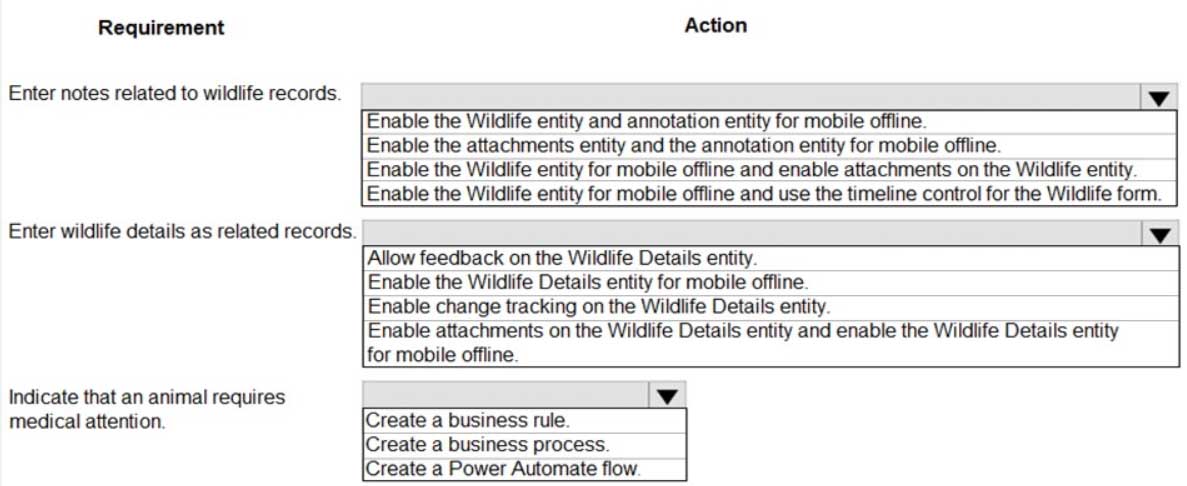
PL-100 Microsoft Power Platform App Maker Part 04 Q09 019 Question 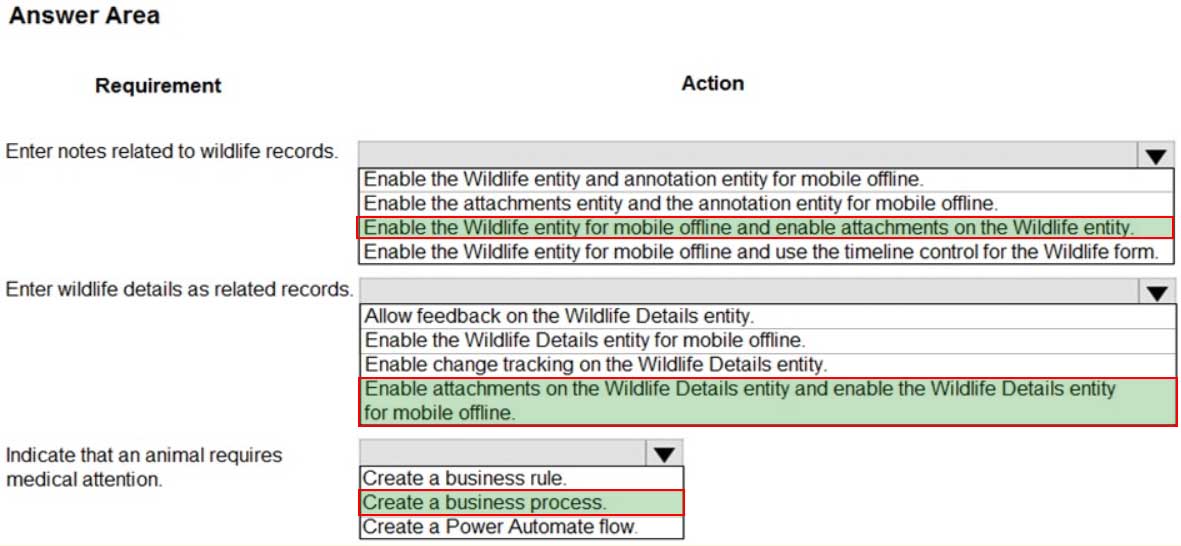
PL-100 Microsoft Power Platform App Maker Part 04 Q09 019 Answer Explanation:Box 1: Enable the Wildlife entity and the annotation entity for mobile offline
Note: As part of the 2020 Wave 2 release, we made generally available offline capabilities for model driven apps for users of Power Apps. Makers and administrators can now configure apps to be available offline on a user’s device, and users can continue to complete their tasks against the local cache on their phone even with intermittent or no network connectivity. When the network is re-established, the users’ changes are seamlessly synchronized back to the cloud.
Box 2: Enable attachments on the Wildlife Details entity and enable Wildlife Details entity for mobile offline.
Box 3: Create a business process.
Business process flows. Ensure that people enter data consistently and follow the same steps every time they work in an app by creating a business process flow.Note: Power Automate includes several types of processes, each designed for a different purpose:
Automated flows. Create a flow that performs one or more tasks automatically after it’s triggered by an event.
Button flows.
Scheduled flows. Create a flow that performs one or more tasks on a schedule such as once a day, on a specific date, or after a certain time.
Business process flows. Ensure that people enter data consistently and follow the same steps every time they work in an app by creating a business process flow.
Workflows and actions. Dynamics 365 customizers may be familiar with the classic Microsoft Dataverse processes, which are workflows and actions. -
A company plans to roll out several Power Apps apps to multiple business units across international operations.
The apps must be managed through an application lifecycle management (ALM) solution to provide a consistent and predictable use experience. All changes to the app must be traceable and documented in a single location. You must be able to revert to a previous version of an app. The app release cycles must be as streamlined as possible.
You need to create an application for the apps.
Which two tools should you use? Each correct answer presents part of the solution.
NOTE: Each correct selection is worth one point.
- Microsoft Azure DevOps
- Microsoft Visual Studio
- Lifecycle Services
- AppSource
- Common Data Service
Explanation:A: DevOps is the combining of two historically disparate disciplines: software development and IT operations. The primary goal of DevOps is to shorten the software development lifecycle and provide continuous integration and continuous delivery (CI/CD) with high software quality. You can use Power Apps build tools to automate common build and deployment tasks related to Power Apps if your DevOps platform is Azure DevOps.
D: Microsoft AppSource is now embedded in the Dynamics 365 home page and throughout the common navigation. It now includes a private gallery of apps available to you within your company. Select Get more apps from the home page or task pane, and navigate to the My Organization tab to see apps that are available to you.
-
A company is consolidating communications processes by using Microsoft Teams and Microsoft Power Platform technologies.
A Power Automate flow monitors social media channels to identify high-impact trends.
When the Power Automate flow identifies the trends, consistently formatted and standardized feedback must be collected from the channel members within Teams.
You need to streamline the Power Automate and Teams communication process.
What should you use?
- AI Builder
- Common Data Service business process flows
- Adaptive cards
- Integrated approval flows
Explanation:
“Microsoft Power Platform and AI Builder components allowed us to quickly deliver an innovative and well-integrated solution within our Dynamics 365 platform for our marketing and sales business partners. The platform is a game-changer in this new world of rapid app delivery.”
Jim Parker: Web and Collaboration Services Manager -
DRAG DROP
A company is building multiple Power Apps apps to support a mobile sales team.
The apps must all share a common control that has custom properties.
You need to create a solution for the apps.
Which objects should you use? To answer, drag the appropriate objects to the correct requirements. Each object may be used once, more than once, or not at all. You may need to drag the split bar between panes or scroll to view content.
NOTE: Each correct selection is worth one point.
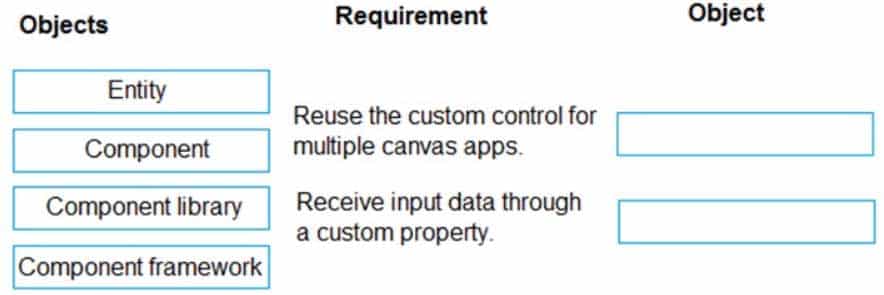
PL-100 Microsoft Power Platform App Maker Part 04 Q12 020 Question 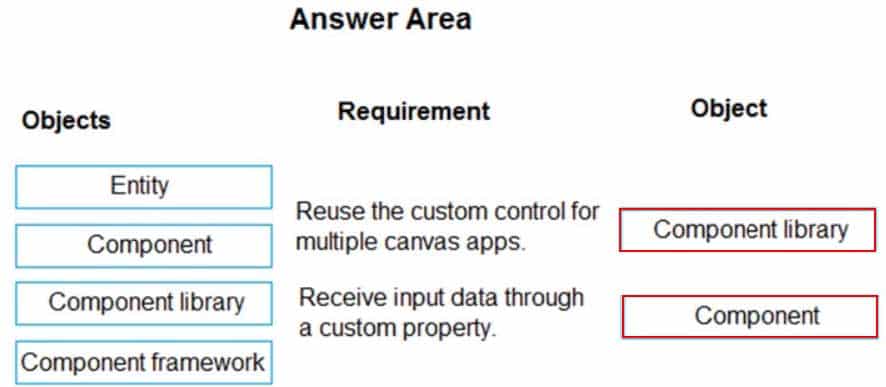
PL-100 Microsoft Power Platform App Maker Part 04 Q12 020 Answer Explanation:Box 1: Component library
Components are reusable building blocks for canvas apps so that app makers can create custom controls to use inside an app, or across apps using a component library. Components can use advanced features such as custom properties and enable complex capabilities.
By creating a component library, app makers easily share and update one or more components with other makers.
Component libraries are containers of component definitions that make it easy to:
– Discover and search components.
– Publish updates.
– Notify app makers of available component updates.Box 2: Component
A component can receive input values and emit data if you create one or more custom properties. -
DRAG DROP
You are designing a canvas app.
You need to select user interface controls to include in the app.
Which control should you use? To answer, drag the appropriate controls to the correct requirements. Each control may be used once, more than once, or not at all. You may need to drag the split bar between panes or scroll to view content.
NOTE: Each correct selection is worth one point.

PL-100 Microsoft Power Platform App Maker Part 04 Q13 021 Question 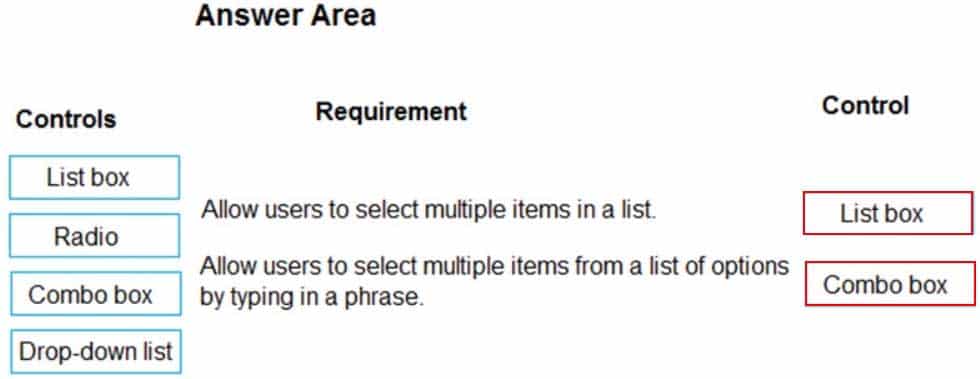
PL-100 Microsoft Power Platform App Maker Part 04 Q13 021 Answer Explanation:Box 1: List box
A List Box control always shows all available choices (unlike a Drop down control) and in which the user can choose more than one item at a time (unlike a Radio control).Box 2: Combo box
A Combo box control allows you to search for items you will select. The search is performed server-side on the Search Field property so performance is not affected by large data sources.Single or multi-select mode is configured via the Select Multiple property.
When searching for items to select, for each item you can choose to show a single data value, two values, or a picture and two values (Person) by modifying the Layout settings in the Data pane.
-
HOTSPOT
A company uses a model-driven app. You create a Power BI sales report.
The executive of the company wants all users to see tiles from the report in the model-driven app.
You need to ensure all users can see the tiles.
What should you do? To answer, select the appropriate options in the answer area.
NOTE: Each correct selection is worth one point.

PL-100 Microsoft Power Platform App Maker Part 04 Q14 022 Question 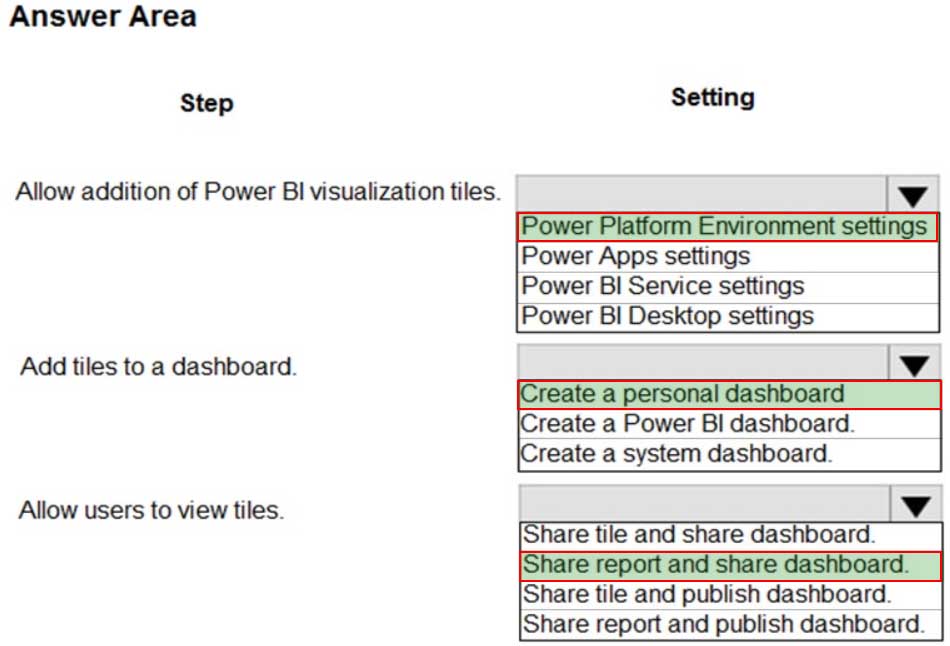
PL-100 Microsoft Power Platform App Maker Part 04 Q14 022 Answer Explanation:Box 1: Power Platform Environment settings
Before users can embed Power BI visualizations on personal dashboards, the organization-wide setting must be enabled.
1. In the Power Platform admin center, select an environment.
2. Select Settings > Product > Features.
3. Under Embedded content set Power BI visualization embedding to On to enable or Off to disable.
4. Select Save.Box 2: Create a personal dashboard
You can embed Power BI tiles on your personal dashboard.
1. Open your app and go to Dashboards.
2. Select an existing personal dashboard or select New to create one.
3. On the dashboard, select an area where you want the tile to appear, and then select Power BI Tile on the toolbar.
4. Add new Power BI tile.
5. In the Power BI Tile dialog, select the workspace and then select the Power BI tile that you want to display on your dashboard. Select Enable for mobile if you want to make the tile available for Dynamics 365 for tablets and Dynamics 365 for phones.
6. Select another area of the dashboard and repeat this step to add another Power BI tile, or other component, such as a chart or list, to your dashboard.
7. Select Save to save your dashboard.Box 3: Share report and share dashboard.
To share your personal dashboard that contains Power BI visualizations you must configure sharing in both Dataverse and Power BI, and the user or group must have the same credentials and appropriate level of access in both services. To share your personal dashboard in your app, go to Dashboards. In the list of dashboards, select the personal dashboard you want, and then select SHARE DASHBOARD. -
You create a Power Platform solution. Solution data is stored in a variety of documented cloud services.
You need to configure the data sources.
What should you do?
- Create a data gateway.
- Use a content pack.
- Create a custom data connector.
- Add metadata to standard entities.
Explanation:Common Data Model is built upon a rich and extensible metadata definition system that enables you to describe and share your own semantically enhanced data types and structured tags, capturing valuable business insight which can be integrated and enriched with heterogeneous data to deliver actionable intelligence.
Common Data Model can be used by various applications and services including Microsoft Dataverse, Dynamics 365, Microsoft Power Platform, and Azure ensuring that all of your services can access the same data.
Note: A wide variety of applications and services can easily access data in a data lake, however, each consumer must understand the format and meaning of the data before it can provide value. The Common Data Model simplifies this process by providing a metadata system that describes the data and standard entities to which producers can map.
-
This is a case study. Case studies are not timed separately. You can use as much exam time as you would like to complete each case. However, there may be additional case studies and sections on this exam. You must manage your time to ensure that you are able to complete all questions included on this exam in the time provided.
To answer the questions included in a case study, you will need to reference information that is provided in the case study. Case studies might contain exhibits and other resources that provide more information about the scenario that is described in the case study. Each question is independent of the other questions in this case study.
At the end of this case study, a review screen will appear. This screen allows you to review your answers and to make changes before you move to the next section of the exam. After you begin a new section, you cannot return to this section.
To start the case study
To display the first question in this case study, click the Next button. Use the buttons in the left pane to explore the content of the case study before you answer the questions. Clicking these buttons displays information such as business requirements, existing environment, and problem statements. When you are ready to answer a question, click the Question button to return to the question.Background
Overview
Wide World Importers is an importer and supplier of fair trade, handmade home goods to independent retailers in North America. The company has a partner company named Tailwind Traders.
One of the products that the company manufactures was recently featured on several major television talk shows and has become very popular.
Wide World Importers is expanding their prospective sales operations to new markets and plans to engage current customers in a more direct manner.
Current environment
Sales representatives submit weekly status reports to regional managers. There is no standardized format for these status reports. The process for managing status reports is challenging.
Wide World Importers has decided to use Microsoft 365, Microsoft Azure, and Power Platform for future app development. Both Wide World Importers and Tailwind Traders have identical Microsoft SharePoint and Azure configurations. Both companies use separate tenants.
Requirements
Application
You must create a mobile app to streamline the creation of status reports by sales representatives. You must make the same app available to Tailwind Traders. The mobile app must meet the following requirements:
– Minimize the use of code.
– Use formulas and expressions when necessary.
– Support a variety of visual layouts.
– Use a SharePoint list to store information about regional managers and sales representatives.
– Use Azure SQL Database to store other data.Status reports
– Sales representatives must provide a weekly status report for all work processes each Monday.
– Representatives must enter the following information for each process:
PL-100 Microsoft Power Platform App Maker Part 04 Q16 023 – If a sales representative submits a status report and assigns the At Risk status to a process, the app must prompt the sales representative to enter a detailed description for the risk. This information must be emailed to the regional manager. If the category is Work/life balance, the information must be carbon copied to the human resources department.
– If a sales representative does not submit a weekly status report by an agreed upon deadline, the system must send an email to remind the sales representative.
– The app must be able to run both online and offline. If the mobile device on which the app runs is connected to the internet, the app must immediately submit the status report.
– You must display a visual indicator in the app so that sales representatives know whether the app is offline before submitting reports.
– When data is submitted offline, the data must be stored in the app until the app is back online.Technical
Regardless of the UI layouts, the data recorded must be standardized in the Azure DB tables. You must use global variables in the app.
Deployment
– Before deploying the app to production, you must ensure that the app conforms to Microsoft accessibility and performance guidelines.
– The completed app and all supporting components must be provided to Tailwind Traders.
– Tailwind Traders must not be able to make changes to any of the components.
– You must use the following version control numbering scheme:
– Major: The last two digits of the year the app is packaged
– Minor: Two digits that represent the month when the app is packaged
– Build: A number that is incremented to represent significant changes to the app
– Revision: The incremented revision for a package
– New versions of the application must completely replace previous versions of the app.
– When identifying versions of the app solution, all dependencies, entities, and user interfaces components must be identified to avoid any unintentional issues caused by reverting individual components to a previous version.
– Previous versions of the mobile app must be available for roll back purposes.
– All versions of software that have been used in production must be retained for five years.Issues
The mobile app has been live for several months. Eight versions of the app have been released since the initial version of the app was deployed to sales representatives. You must revert the app to an earlier version and redesign some features.
User1 often works in a warehouse that does not have internet connectivity. User1 needs to edit an existing status report and submit a new status report.
Several sales representatives have accessibility restrictions. User2 is visually impaired and cannot see images. User3 is unable to use a mouse.
-
You need to provide the app to Tailwind Traders.
What should you do?
- Within Managed Properties, set the value of the Allow customizations option to true. Export the app as a managed solution.
- Use the Share App feature.
- Within Managed Properties, set the value of the Allow customizations option to false. Export the app as a managed solution.
- Within Managed Properties, set the value of the Allow customizations option to false. Export the app as an unmanaged solution.
Explanation:Scenario: The completed app and all supporting components must be provided to Tailwind Traders. Tailwind Traders must not be able to make changes to any of the components.
Managed Solution: A managed solution is a finalized solution that can be distributed and installed. They are created by exporting an unmanaged solution by setting restrictions to prevent any further customizations. The whole point of Managed is locking down the Component states so they cannot be edited. Deleting the Managed Solution will remove all its customisations as well as data contained. Managed Solutions become read only once deployed so they cannot be manipulated.
-
DRAG DROP
You need to ensure that the app can support the needs of User2 and User3, and meets the production deployment requirements.
Which tools should you use? To answer, select the appropriate tool in the answer area.
NOTE: Each correct selection is worth one point.

PL-100 Microsoft Power Platform App Maker Part 04 Q16 024 Question 
PL-100 Microsoft Power Platform App Maker Part 04 Q16 024 Answer Explanation:Box 1: App Checker
Scenario: Several sales representatives have accessibility restrictions. User2 is visually impaired and cannot see images. User3 is unable to use a mouse.Users who have vision, hearing, or other impairments can use your canvas app more easily and successfully if you consider accessibility as you design how the app looks and behaves. If you’re not sure how to make your app more accessible, you can run the App Checker Accessibility checker in Power Apps Studio.
Box 2: Solution Checker
Scenario: Before deploying the app to production, you must ensure that the app conforms to Microsoft accessibility and performance guidelines.Use solution checker to validate your model-driven apps in Power Apps.
-
HOTSPOT
You need to resolve the issue for User1.
What should you use? To answer, select the appropriate options in the answer area.
NOTE: Each correct selection is worth one point.
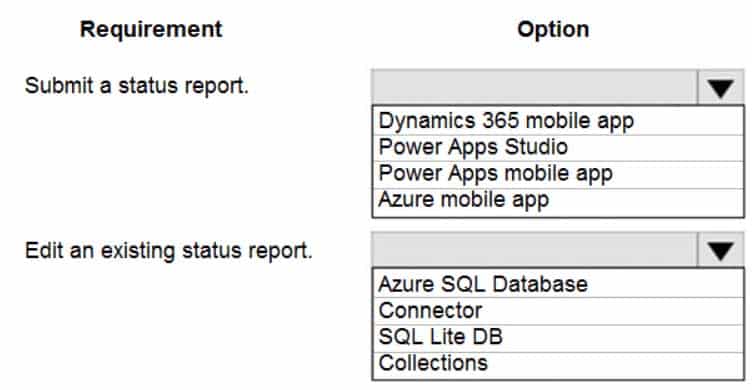
PL-100 Microsoft Power Platform App Maker Part 04 Q16 025 Question 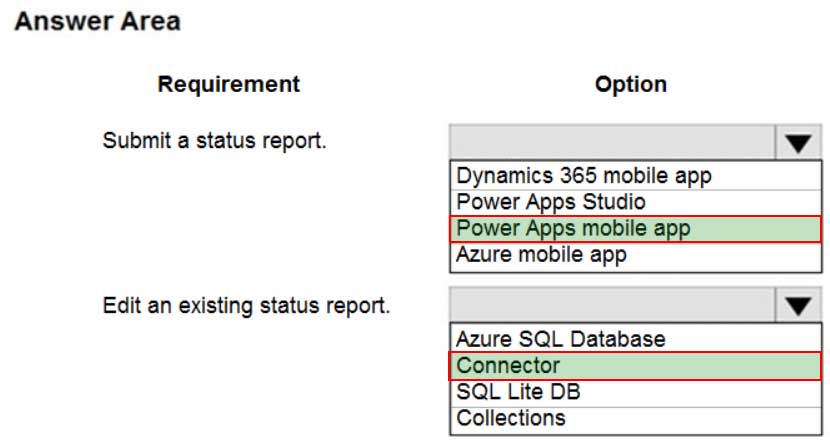
PL-100 Microsoft Power Platform App Maker Part 04 Q16 025 Answer Explanation:Box 1: Power Apps mobile app
Scenario:
– User1 often works in a warehouse that does not have internet connectivity.
– User1 needs to edit an existing status report and submit a new status report.
– The app must be able to run both online and offline. If the mobile device on which the app runs is connected to the internet, the app must immediately submit the status report.You can build offline capabilities in your PowerApps app so your app users can access some data or save some data even when they don’t have an internet connection.
Box 2: Connector
Scenario: Azure SQL Database is used to store other data
Use the SQL Server connector to connect to SQL Server, in either Azure or an on-premises database, so that you can manage your data with create, read, update, and delete operations. -
DRAG DROP
You need to modify the app design to meet the accessibility needs of the sales associates.
Which properties should you configure? To answer, drag the appropriate properties to the correct restrictions. Each property may be used once, more than once, or not at all. You may need to drag the split bar between panes or scroll to view content.
NOTE: Each correct selection is worth one point.
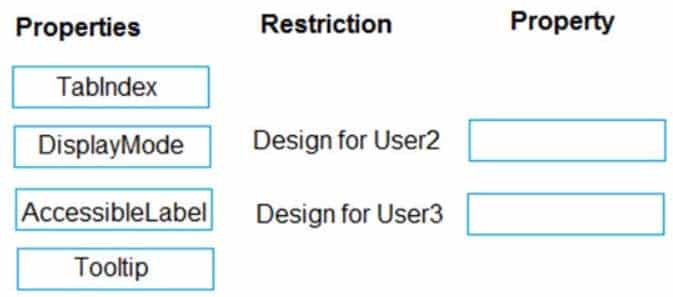
PL-100 Microsoft Power Platform App Maker Part 04 Q16 026 Question 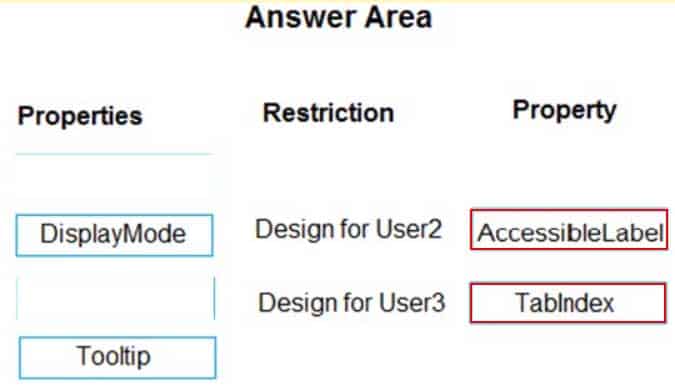
PL-100 Microsoft Power Platform App Maker Part 04 Q16 026 Answer Explanation:Box 1: Accessible Label
Scenario: Before deploying the app to production, you must ensure that the app conforms to Microsoft accessibility and performance guidelines.
User2 is visually impaired and cannot see images.Accessible Label is a label for screen readers.
An empty value for Image, Icon, and Shape controls will hide the controls from screen reader users.
Box 2: Tab Index
User3 is unable to use a mouse.Tab Index determines if the control participates in keyboard navigation.
Keyboard navigation is an important aspect of any app. For many, the keyboard is more efficient than using touch or a mouse. The navigation order should:Mirror what is seen visually.
Only have a tab stop at controls that are interactive.
Follow either an intuitive across and then down “Z” order or a down and then across “reverse-N” order. -
You need to create the mobile app.
Which type of app should you create?
- model-driven app
- portal app
- Microsoft 365 web app
- canvas app
Explanation:
An accessible canvas app will allow users with vision, hearing, and other impairments to successfully use the app. In addition to being a requirement for many governments and organizations, following the below guidelines increases usability for all users, regardless of their abilities.
-
-
This is a case study. Case studies are not timed separately. You can use as much exam time as you would like to complete each case. However, there may be additional case studies and sections on this exam. You must manage your time to ensure that you are able to complete all questions included on this exam in the time provided.
To answer the questions included in a case study, you will need to reference information that is provided in the case study. Case studies might contain exhibits and other resources that provide more information about the scenario that is described in the case study. Each question is independent of the other questions in this case study.
At the end of this case study, a review screen will appear. This screen allows you to review your answers and to make changes before you move to the next section of the exam. After you begin a new section, you cannot return to this section.
To start the case study
To display the first question in this case study, click the Next button. Use the buttons in the left pane to explore the content of the case study before you answer the questions. Clicking these buttons displays information such as business requirements, existing environment, and problem statements. When you are ready to answer a question, click the Question button to return to the question.Background
Contoso, Ltd. produces industrial furnaces. The company is struggling to meet increased demand in production orders.
The company has corporate offices and manufacturing plants in Germany. The company also has offices and manufacturing plants in other regions of the world.
The company purchases a plant from another company. The plant has been in operation for over 25 years.
Current environment
Overview
Operations for the company are managed very informally. Only a small number of long-term employees are aware of all manufacturing processes.
Accounting system and purchasing
– The company has a cloud-based ERP/accounting system and uses the General Ledger, Accounts Receivable, and Accounts Payable modules. The current system does not have any modules that handle shop floor or manufacturing planning functionality.
– Employee information is maintained only within the accounting system. Access to the information is strictly controlled due to privacy regulations and company policies.
– All purchasing of raw materials is performed based on bills of material (BOMs) generated by the engineering department when engineering prints are created.
– The corporate office uses Dynamics 365 Finance. The operations manager reports that Dynamics 365 Finance will not be implemented for the manufacturing plants for at least five years.Manufacturing and planning
– The plant that Contoso, Ltd. acquires uses Microsoft Excel workbooks and Microsoft Word documents to track the sales pipeline, requests for quote responses, and work estimates. The documents are stored on shared network drives.
– Printed engineering drawings are sometimes accidently used across orders. This results in rework, cost over runs, and missed deliveries.
– The company uses Job Traveler documents to detail the operations that need to be performed and the materials needed for a given job number.Sales
– Requests for quotes are currently stored in a Sales Log workbook. The workbook includes the following information:
– Customer request number
– Customer name
– Description
– Estimated value of the sale
– Status of the Request for Quote (RFQ) with the values of Won, Lost, No Bid, and Cancelled
– Names of the sales manager, salesperson, and estimator
– Name of the product line
– Date the quote was sent to the customer
– Approximate start and finish dates of the project
– Date the order was received, if won
– Job number, which is assigned if won
– The company has a formal process in place for managing estimates. Some sales quotes lack required supporting documentation including estimates for labor and materials even though a formal process is in place. The company wants to incorporate the formal process as part of an app.
– Salespeople often do not set status of RFQs in the Sales Log to Won when a sale is closed and the customer purchase order is received.
– An accurate sales pipeline and win/loss information cannot currently be reported because the close probability field in the Sales Log is being set to 100% when a sale is closed and 0% when a sale is lost.
– Setting up a folder system on the network drive by a customer had not improved the hand-off of the current version of the sales quote to manufacturing.Requirements
Solution
You plan to create a solution that uses Microsoft Teams and Power Platform.
You must convert the Sales Log workbook to a Common Data Service database.
Each department will have a separate Teams channel. Employees must only be able to access the channel for their department. All employees and management will have read access to a general company channel. The Teams site must include the following channels:
Sales
– The Sales dashboard must reside in the Sales channel and must include information about active quotes, sales pipeline, and year-to-date sales KPIs for sales quotas by region.
– All Sales-related documents must be stored in folders in the files location for this channel. Document versioning will be enabled. You must store the 10 most recent versions of a document.Manufacturing
– A dashboard that shows a capacity Heat map by month as well as expected sales that are likely to close for the next month.
– A sortable listing of all in-process jobs from the Job Setup table, by customer, start date, and product.
– Printed paper drawings must no longer be used. The drawings must be stored in folders in the files location for the manufacturing channel.General
You must create the following apps:
Time Tracking
You must create a canvas app to track time for each employee on mobile devices. The app must include the following:
– a Sign-in screen
– a screen to list the week’s time entries for the employee
– a screen to edit current time entries for the employeeThe app must meet the following requirements:
– The app must store its data in the existing on-premises Microsoft SQL Server instance.
– Employees must only be able to access their own time tracking records from the app.
– Employees must record all time spent in the fabrication of each customer job.
– Employees must only be able to modify time records for the current and previous day.
– Employees must be able to scan their badges to check in and out of work. Each badge contains the employee name and a current picture.
– A QR code must be added to all employee badges. The code must include the employee’s number.
Job Traveler documents must be printed as PDF documents and must include UPC E barcodes for the job number and task number. The barcodes will be used with the time tracking application.Sales
The Sales app must meet the following requirements:
– Provide a central location for all sales pipeline and quote information that is easily accessible and maintains all of the versions of the estimate, quote, and engineering documents.
– Include a dashboard that shows all currently active quotes, their status in the sales cycle, the probability of closing, and estimated manufacturing and installation dates, by customer, product division, status, and salesperson.
– The Sales Log app must enforce process standards related to the completion of estimates and supporting materials needed during the sales lifecycle.
– Automatically perform the following actions immediately when a sale is won:
– Generate a sequential job number.
– Copy key sales information to the Job Setup entity used by manufacturing.
– If the sale is lost, the Status field must be set to Lost and the reason for the loss must be entered into a provided text field. The reason must be added to the end of the description field.
– Ensure that employees can easily update the Sales Log even if they are at a customer site.Manufacturing and planning
The app must meet the following requirements:
– Provides features to plan and predict capacity resource requirements for current and upcoming orders in the pipeline.
– Replace paper timesheets and track check-in, check-out, breaks, and the time spent on each job task.
– Record time elapsed while performing work and for viewing of engineering drawings.
– The Job Setup entity must store its data in the existing on-premises SQL Server instance.
– Job Traveler documents must be generated as a PDF document and printed from the Job Setup entity.Issues
– Users report that the customer request number is difficult to interpret. They request that you change the number to a system generated sequential number.
– The operations manager reports that users often incorrectly sign in to the time tracking app. The operations manager asks that the time tracking app display the employee’s photo once they have scanned their badge.
– Users want to be able to see their weekly total time entered from all screens.
– Testers report that they can see time entries in the Time Tracker app, not just their own. Additionally, they can also edit any existing time entries.-
You need to modify the entity form to resolve the customer request number issue.
What should you do?
- Use a calculated field
- Change the data type of the customer request number field to Lookup
- Change the data type of the customer request number field to Autonumber
Explanation:Scenario: Users report that the customer request number is difficult to interpret. They request that you change the number to a system generated sequential number.
Autonumber columns are columns that automatically generate alphanumeric strings whenever they are created.
Incorrect Answers:
B: The LookUp function finds the first record in a table that satisfies a formula. -
HOTSPOT
You need to implement features for the solution.
Which Power Platform component should you use for each feature? To answer, select the appropriate options in the answer area.
NOTE: Each correct selection is worth one point.
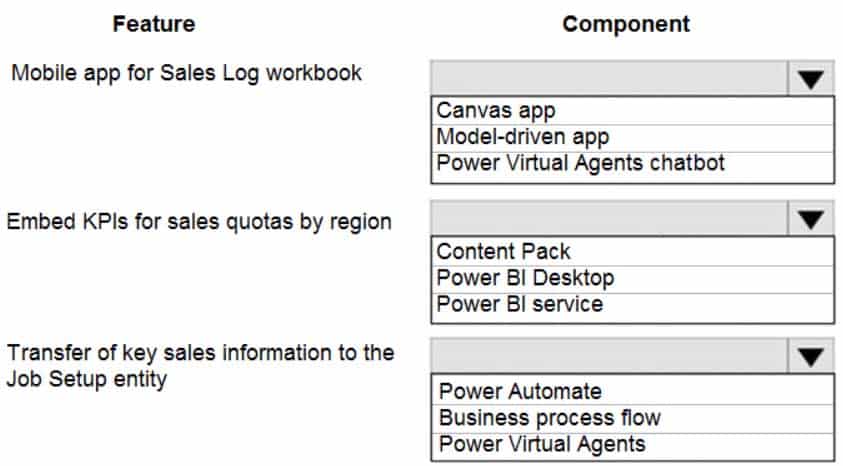
PL-100 Microsoft Power Platform App Maker Part 04 Q17 027 Question 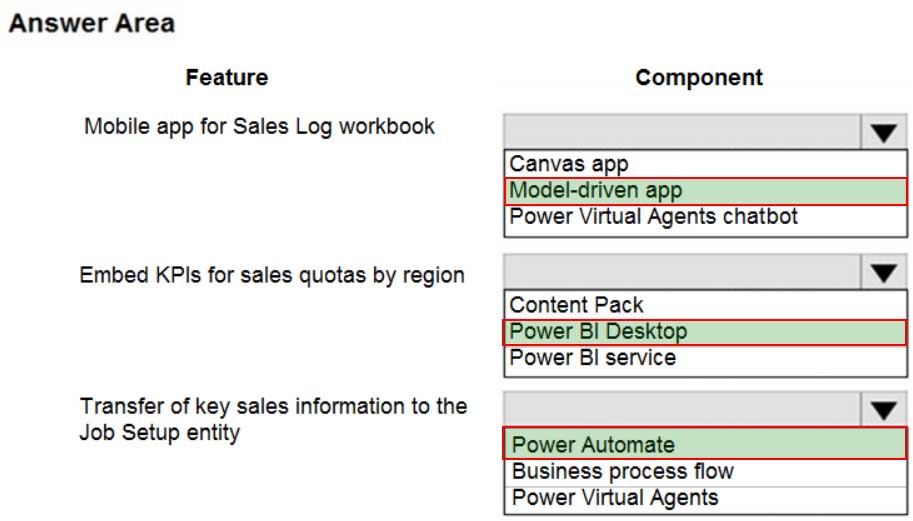
PL-100 Microsoft Power Platform App Maker Part 04 Q17 027 Answer Explanation:Box 1: Model-driven app
The Sales app must meet the following requirements:
- Provide a central location for all sales pipeline and quote information that is easily accessible and maintains all of the versions of the estimate, quote, and engineering documents.Compared to canvas apps, model-driven apps in PowerApps are based on underlying data — specifically, the data stored in Common Data Service (CDS).
Box 2: Power BI Desktop
You can create a KPI in Power BI Desktop.
1. Open your report editor in Power BI Desktop then select a report on which you are working.
2. On your right, you will see a Visualizations pane and a Fields pane.
3. From the Visualizations pane, select the KPI visual.
4. Etc.Box 3: Power Automate
-
You need to connect to the data source for the Job Setup app.
What should you do?
- Configure a scheduled synchronization with the Common Data Service database
- Configure SQL Server database permissions
- Create a stored procedure that retrieves time records for a specific employee
- Configure an on-premises data gateway
Explanation:Scenario: The Job Setup entity must store its data in the existing on-premises SQL Server instance.
The on-premises data gateway acts as a bridge to provide quick and secure data transfer between on-premises data (data that isn’t in the cloud) and several Microsoft cloud services. These cloud services include Power BI, Power Apps, Power Automate, Azure Analysis Services, and Azure Logic Apps. By using a gateway, organizations can keep databases and other data sources on their on-premises networks, yet securely use that on-premises data in cloud services.
-
HOTSPOT
You need to resolve the issues found during testing.
Which option should you use? To answer, select the appropriate options in the answer area.
NOTE: Each correct selection is worth one point.

PL-100 Microsoft Power Platform App Maker Part 04 Q17 027 Question 
PL-100 Microsoft Power Platform App Maker Part 04 Q17 027 Answer Explanation:Box 1: Security role
Scenario: Employees must only be able to access their own time tracking records from the app.
Testers report that they can see time entries in the Time Tracker app, not just their own.Box 2: Field-level security
Scenario: Employees must only be able to modify time records for the current and previous day.
Testers report that they can edit any existing time entries.Box 3: Hierarchical security
You use field security tables to apply field-level security, which restricts field access to specified users and teams. -
You need to resolve the user’s issue with the time tracking app.
Which two actions should you perform? Each correct answer presents part of the solution.
NOTE: Each correct selection is worth one point.
- Add a component to the time tracking screen for tracking total time.
- Create a new component inside of the component library for the time tracking app.
- Upload the component to AppSource.
- Add the Total Time field to the screen and set the value of the field property to Rollup.
Explanation:Scenario Issue: Users want to be able to see their weekly total time entered from all screens.
A component library provides a centralized and managed repository of components for reusability.
-
-
You are developing a canvas app to monitor time. The app includes a Text Input control named TIC1 and a Timer control named TIM1.
You need to set TIM1 to a default value.
What should you do?
- In the OnChange property of TIC1, set the value of the Text property for TIC1 to a context variable that stores the duration value. Assign the value of the variable to the OnTimerStart property for TIM1.
- Assign the Text property of TIC1 to the Duration property of TIM1.
- Assign the Text property of TIC1 to the OnSelect property of a TIM1.
- Add the clock icon to the app and use the OnSelect property to set the Duration property for TIM1.
Explanation:
The OnTimerStart, OnTimerEnd and OnSelect are the configurations where you can add your code. -
HOTSPOT
A company is building a Power Apps app to track key project tasks.
Users assign three tasks a risk status on a scale of 0 to 100 by using slider input controls named RiskStatus on the app. The highest risks use the risk status value of 100.

PL-100 Microsoft Power Platform App Maker Part 04 Q19 028 If the combined value of all the tasks is 150 or above, a header bar on the screen must display the text HIGH RISK.
You need to configure a solution to change the text on the header bar.
How should you configure the app? To answer, select the appropriate options in the answer area.
NOTE: Each correct selection is worth one point.

PL-100 Microsoft Power Platform App Maker Part 04 Q19 029 Question 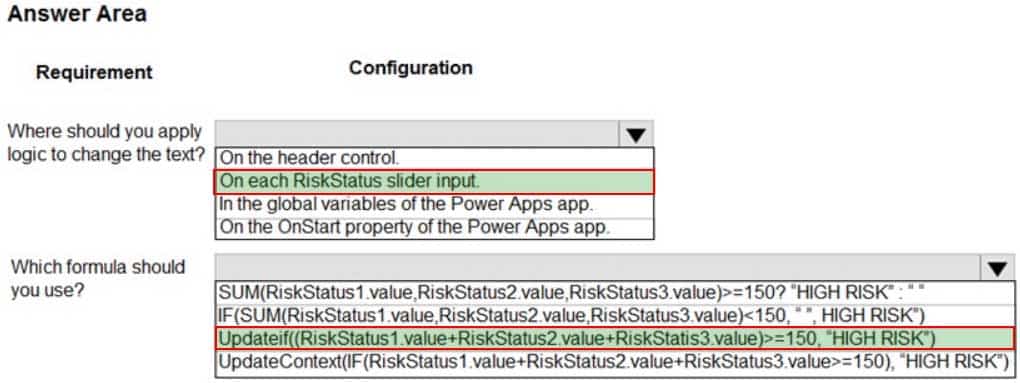
PL-100 Microsoft Power Platform App Maker Part 04 Q19 029 Answer Explanation:Box 1: On each RiskStatus slider input
You can change the value based on input.Box 2: Updateif(..)
Use the UpdateIf function to modify one or more values in one or more records that match one or more conditions. The condition can be any formula that results in a true or false and can reference columns of the data source by name. The function evaluates the condition for each record and modifies any record for which the result is true. -
You create a Power Platform solution. Solution data is stored in a variety of documented cloud services.
You must also be able to connect to one or more industry data sources.
You need to configure the data sources.
What should you do?
- Create a business process flow.
- Create a data policy template.
- Create a UI flow.
- Use an existing data connector.
Explanation:In Power Apps, add a data connection to an existing canvas app or to an app that you’re building from scratch. Your app can connect to SharePoint, Common Data Service, Salesforce, OneDrive, or many other data sources.
Note:
Add data source
1. In the center pane, select connect to data to open the Data pane.
2. Select Add data source.
3. If the list of connections includes the one that you want, select it to add it to the app. Otherwise, skip to the next step.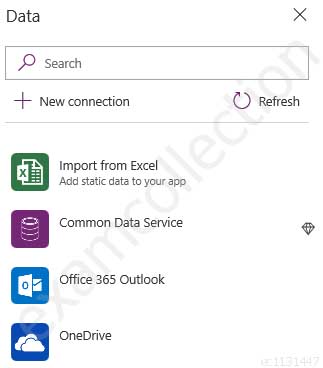
PL-100 Microsoft Power Platform App Maker Part 04 Q20 030 4. Select New connection to display a list of connections.
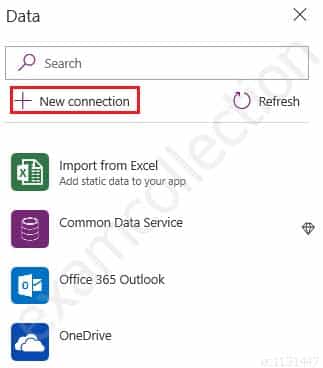
PL-100 Microsoft Power Platform App Maker Part 04 Q20 031 5. In the search bar, type or paste the first few letters of the connection you want, and then select the connection when it appears.
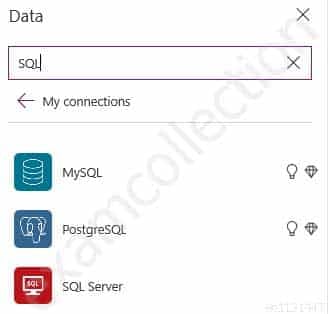
PL-100 Microsoft Power Platform App Maker Part 04 Q20 032 6. Select Create to both create the connection and add it to your app.